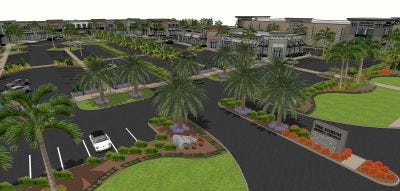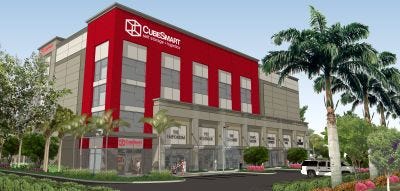Adding self-storage as an anchor to a mixed-use real estate project offers many benefits to developers and the community. Here are some of the features and complexities of these in-demand projects.
July 13, 2017
By Jesse Balaity
Self-storage operators know their facilities can be good neighbors, especially when they transition from being gated fortresses and invite community engagement as anchors of mixed-use projects. While mixing commercial, residential and retail adds complexity, it can also solve planning and economic challenges.
Planning and Economics
Sketch out a bustling urban streetscape in your mind. What do you see? Restaurants spilling onto sidewalks, apartment buildings with balconies, a pocket park with children playing, or a self-storage facility? Self-storage professionals might see the latter, but for the rest of the world, storage occupies the same realm as parking garages and utilities structures. They’re all necessary elements for a city to function, but they don’t contribute to the vitality of urban life.
A desire for activated streetscapes pervades urban zoning regulations, often with specific requirements for human-occupied interior spaces visible from the public way. This may be for a specified building depth, at the ground level or for several levels above.
For example, the new urbanist code that governs my neighborhood in downtown Sarasota, Fla., requires 20 feet of habitable space as a liner building around any non-occupied structure, like parking. Such configurations can be ideal for self-storage, as the habitable building area close to the street is also the highest revenue-producing space for retail, office, restaurant or even residential use. Greater human activity on a utilitarian site also enhances security (or the perception of security).
Now envision a suburban lifestyle center. What do you see this time? A shaded plaza with restaurants and retail shops, a movie theater, a specialty grocery store, maybe a department store anchoring each end? But wait, are department stores still a thing, or is that the shell of a shuttered Sears in your sketch? Perhaps that big box is better suited for self-storage.
Suburban zoning often relegates self-storage to commercial or industrial districts, but may allow it as a conditional use or part of a planned-unit development (PUD). PUDs can provide developers with the freedom to include self-storage in a master plan with other land uses, even if the surrounding zoning excludes it.
There are several arguments for this. First, developers must profit from all parcels in a PUD, so it’s in their best interest to consider compatibility and provide adequate buffers in the master plan. Second, a PUD will include design standards that are often more restrictive than those of the prevailing land-development code. This ensures all industrial, commercial and residential buildings complement the overall community design, often interpreted in vernacular architectural styles. Finally, a goal of PUDs is to reduce traffic by fulfilling residents’ needs onsite. This justifies the inclusion of any reasonable use within the master plan.
Even where zoning allows for dedicated self-storage, a mixed-use development can maximize a site’s economic potential. As efficient and profitable as storage facilities are, there are other uses that generate even more revenue per square foot of building area.
At one extreme, consider a storage facility in Manhattan, where small, ground-floor retail spaces can lease for more than $1,000 per square foot. Self-storage only makes economic sense deeper into the building, on upper floors, or in areas with less exposure and natural light.
Or consider a large site in a growing suburban neighborhood with excess building area potential once the self-storage pro forma is satisfied. Suburban sites often designate excess space for RV storage or future expansion, but savvy investors will analyze the marketplace and meet additional demand with other uses for a shorter-term return on investment. This can be as simple as an outparcel restaurant pad, or as insightful as an apartment component that provides built-in customers for self-storage.
Challenges
Mixed-use projects can be spread across a parcel or combined within a single structure. Each configuration has its own challenges.
With mixed-use sites, the self-storage circulation paths often overlap other uses, making it impractical to implement site access controls. This, in turn, limits the use of exterior-access units. Overlapped circulation also increases the risk of large trucks interfering with retail traffic, pedestrians and occupied outdoor areas such as sidewalk dining and plazas. Finally, there’s the cost of meeting design criteria. Design compatibility often requires more windows, increased façade articulation and higher quality finishes compared to freestanding facilities.
The design for Forum at Greenbriar, a mixed-use project in Jacksonville, Fla., demonstrates one solution to these challenges. The project combines Atlantic Self-Storage as a freestanding anchor, two retail buildings, a restaurant outparcel, and a mixed-use retail and office building in a cohesive lifestyle-center setting. The buildings share a common architectural language, landscape palette and hardscape design. Self-storage traffic shares site access with other uses; however, within the site, one retail building creates a physical barrier to the storage traffic and blocks views to the loading zones.
A mixed-use building has all the same challenges as the mixed-use site and more. The efficient structural system, often on a 10-by-10-foot grid or with bearing walls spaced 10 feet apart, doesn’t work for other uses. When self-storage occupies space above other uses, there must be a longer span structural system or a hybrid system with more columns on upper levels and transfer beams to fewer columns on the ground level. Building design must consider separated loading zones and pedestrian entrances, security measures for any shared internal circulation, and fire separation between uses.
Beyond the technical issues, we find the biggest challenge with mixed-use self-storage is designing for multiple identities. The storage facility is the building anchor and, as such, must have a strong outward presence. Often this requires bright colors like CubeSmart’s tanager red or Extra Space Storage’s wasabi green. Retail, office or residential tenants shouldn’t feel like occupants. They must have their own complementary but separate identities. Building massing must also prevent the appearance of a self-storage monolith sitting atop other tenant spaces or make the smaller spaces feel like an afterthought.
 For our Pompano Beach, Fla., project, which will be professionally managed by CubeSmart, we exaggerated the height of the ground-floor retail façade to appear as half of the building height, even though retail occupies one-fifth of the actual height. This avoids the sense of the self-storage crushing the retail spaces. The added height also lets us place retail signage higher on the wall for better visibility.
For our Pompano Beach, Fla., project, which will be professionally managed by CubeSmart, we exaggerated the height of the ground-floor retail façade to appear as half of the building height, even though retail occupies one-fifth of the actual height. This avoids the sense of the self-storage crushing the retail spaces. The added height also lets us place retail signage higher on the wall for better visibility.
 To test the viability of the design, we theoretically removed the upper self-storage levels and then assessed whether the ground floor could stand on its own as a desirable retail center. We put ourselves in the shoes of a prospective tenant, asking whether we would lease a space here. Does anything about the storage facility detract from the retail experience, and what makes it more attractive than nearby shopping centers? This is where design really matters, as leasing agents will inevitably need to overcome preconceived notions about self-storage sites.
To test the viability of the design, we theoretically removed the upper self-storage levels and then assessed whether the ground floor could stand on its own as a desirable retail center. We put ourselves in the shoes of a prospective tenant, asking whether we would lease a space here. Does anything about the storage facility detract from the retail experience, and what makes it more attractive than nearby shopping centers? This is where design really matters, as leasing agents will inevitably need to overcome preconceived notions about self-storage sites.
For Pompano Beach, we proposed a bold design language, turning a utilitarian building type into a beacon. We exceeded the standards of competing retail properties with a generous pedestrian plaza, enhanced landscaping, and a unique mixture of materials and textures. The façade layering also helps with the retailers’ identity, achieving a subtle distinction between being under CubeSmart and being in front of CubeSmart.
The Future
We see several development trends that will continue in the coming decade. The shift from suburban sprawl to walkable communities, downsizing Baby Boomers, downtown residential projects spreading from major cities to smaller urban centers, and the proliferation of form-based design codes are just a few. For each of these trends, mixed-use projects give self-storage facilities the potential to be the best possible neighbors.
Jesse Balaity is a design consultant and owner of Balaity Property Enhancement, an architecture and project-management firm. He’s also a frequent collaborator with Patrick M. Pillot, Architect, in Sarasota, Fla., where he’s contributed to the design of more than 30 self-storage facilities. He frequently assists storage clients through the conceptual design and approvals processes, helping navigate through design regulations and neighborhood compatibility concerns. For more information, call 941.961.9079; e-mail [email protected]; visit www.balaity.com.
You May Also Like





